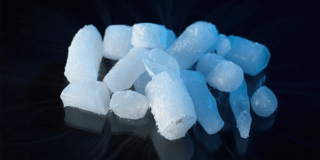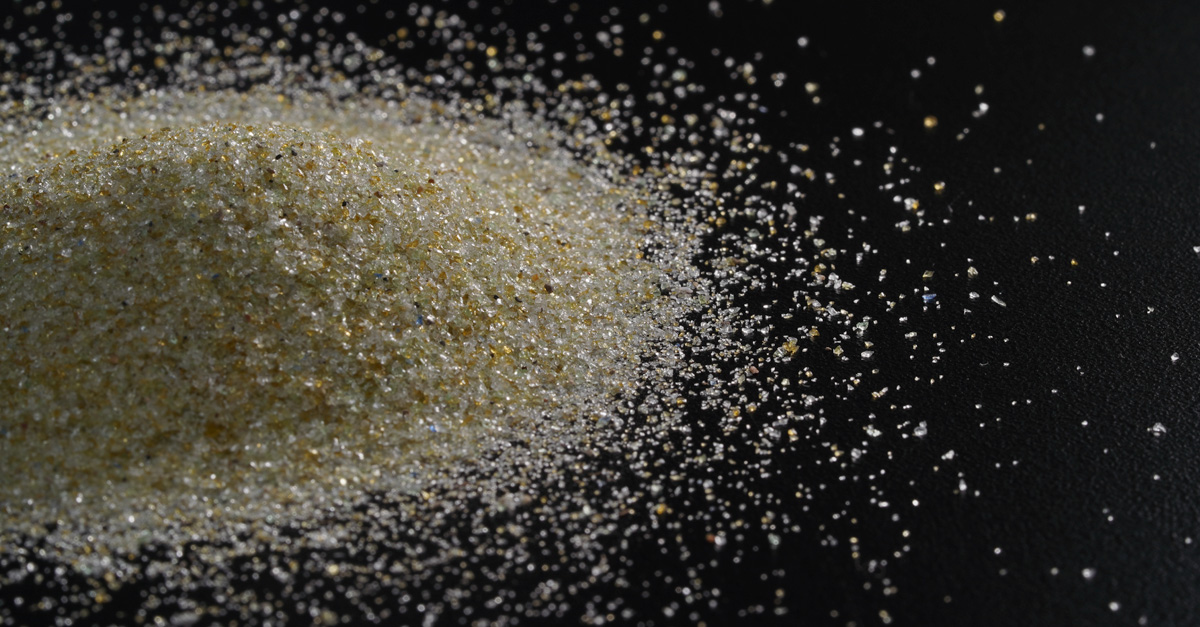
Overview: DRY ICE CLEANING
You may recognize the “smoke” produced by dry ice from the cauldron at the neighborhood haunted house at Halloween, or maybe you have seen it used to keep your food cold when you receive a shipment to your home from a meal delivery company. But did you know that you can clean with it?
Scientists and engineers have been developing technology that can harness the power of dry ice for the removal of dirt, grime, rust and other surface contaminants. This blog examines the machinery being used to optimize the dry ice blasting process, its special maintenance requirements, cost and operational challenges and how it matches up against the versatility of Dustless Blasting machines. To read about the various applications in which dry ice blasting has been used, check out our blog here.
What is Dry Ice Blasting?
To get the low down on the science of dry ice blasting, check out our blog: Comparing Dry Ice Cleaning to Dustless Blasting. As a recap, dry ice blasting is a nonabrasive, nontoxic cleaning process that utilizes solid carbon dioxide (CO2) pellets — commonly known as dry ice — as the blasting media. When dry ice pellets are accelerated and directed at a surface, they sublimate (i.e., move from a solid to a gas state) upon impact, effectively removing contaminants with minimal residue or damage to the surface. Dry ice cleaning can be a tidier, environmentally friendly option as compared to traditional cleaning methods such as hand tools or use of chemicals in certain specialty applications.
How Dry Ice Blasting Equipment Works
So how do dry ice blasting machines operate? Like Dustless Blasting blast pots, dry ice cleaning technology uses compressed air (the power supply) as the propellant. Dry ice pellets or shavings are shot through a hose and specialized nozzle — designed to optimize the speed and trajectory of the dry ice — which is aimed at the target surface. Upon impact, heat changes the properties of the CO2, creating a tiny explosion that effectively dislodges dirt and grime and then removes it from the substrate.
Most dry ice blasters on the market include an air compressor, temperature regulated storage for dry ice, a feeding system consisting of hosing and a nozzle and controls that allow regulation of air flow and media usage. And, just like Dustless Blasting machines, dry ice blasters come in different sizes and capacities, depending on the scope of the job and the user's requirements.
Maintaining A Dry Ice Blasting MACHINE
Manufacturers of dry ice blasting equipment use high quality materials including aluminum and stainless steel plus advanced precision engineering to ensure durability and optimize performance. Modern machines often include features such as variable dry ice feed rates, adjustable pressure and designs with user comfort in mind. Regular maintenance is crucial for dry ice blasters to function effectively and safely while dry ice blast cleaning. Key tasks include:
Cleaning and Inspection
Regularly inspect the dry ice machine for any signs of wear and tear, and clean it thoroughly after each use.
Lubrication
Lubricate moving parts as needed to prevent friction and ensure smooth operation.
Check for Air Leaks, Condensation or Frozen Parts
Air leaks can affect machine performance, so inspect the hoses and connections for any signs of leakage. Also ensure that water from condensation is not freezing within the machine or hoses creating a blockage.
Replace Worn Parts
Replace any worn or damaged parts of the dry ice machine promptly to prevent breakdowns during use. Following the manufacturer's maintenance schedule is crucial to keep the equipment in optimal working condition and prolong its lifespan. Unlike Dustless Blasting machines — which are designed for easy repairs and limited wear parts — many dry ice cleaning machine parts are proprietary, so keep this in mind when budgeting for maintenance.
Limitations of Dry Ice Blasting MACHINES & MEDIA
While the technology is certainly impressive, dry ice blast cleaning is a specialized technique that requires significant investment both to start and maintain.
-
Cost: The cost of a dry ice blasting machine varies depending on the size, features, and manufacturer. Basic dry ice blasters can start at around $10,000, while more advanced and larger machines can cost upwards of $50,000. And that is just the machine. The cost of dry ice itself is typically calculated by weight and can average between $1 and $3 per pound. Using a pellet dry ice machine, blasters can use up to 2.5 lbs of dry ice per minute. That's $450/hr in media costs alone!
-
Availability & Storage: Dry ice melts at room temperature, so proper storage facilities and adequate transportation to/from a job site are costs to be considered. Additionally, depending on geographic location, it may be difficult to come by quickly. Access to a reliable supply of dry ice media is crucial. Many providers choose to purchase a pelletizer at significant costs to produce pellets internally in order to eliminate sourcing from other providers. When purchasing dry ice from a third party, it is important to inquire about the specific form (pellets, blocks, etc.) and quantity needed for compatibility with a particular machine.
-
Effectiveness & Versatility: Dry ice blasting technology may not be as effective as sandblasting, for example, on heavily corroded or severely damaged surfaces, nor is it compatible with soft or porous materials. It also is not ideal for applications where a deep anchor profile is necessary for paint or coatings to adhere to. Because of its nonabrasive composition, dry ice cannot achieve white metal finishes without the addition of another abrasive media.
-
System Sensitivity: Because of the unique chemical composition of dry ice, air temperatures that exceed a certain level can cause damage to the internal components of a dry ice blasting unit. In addition, air compressors are known to build up moisture within the system. This condensation can freeze up the ice and air supplies and the flow of pellets or shavings through the blasting system, wreaking internal havoc and requiring the stoppage of a project for troubleshooting.
-
Workplace Safety: Proper safety precautions must be taken to protect operators and surrounding areas from cold exposure, projectiles, and the production of CO2 gas. This could require the purchase of blasting cabinets for a more controlled ice blasting environment — yet another cost. Operators must wear proper PPE and stay vigilant in protecting themselves from the cold, the noise and the gas generated during blasting. Additionally, be aware of the safety precautions required for handling dry ice safely, as it can cause burns. Lastly, dry ice emits CO2 gas as it melts. Exposure to gas can cause unconsciousness and other serious health concerns, so it is required that all dry ice blasters receive proper training on packaging, storing and handling this product to allow for adequate ventilation.
-
Learning Curve: Operators need training and practice to understand the nuances of dry ice blasting machines. As a line-of-sight cleaning method, the operator may not be able to reach difficult-to-access areas. And, to keep jobs rolling, dry ice blasting companies may consider assigning more than one operator to a job — one person to blast and one person to refill and regulate the machine; thereby increasing labor costs.
Compare & Contrast: Abrasive Blasting Equipment vs. Dry Ice Blasting Equipment
There's no doubt about it — dry ice blasting is a powerful tool for certain cleaning applications and small parts finishing. We have covered the limitations of this particular form of blasting above. But how do the Dustless Blasting machines compare?
- Toughness: The biggest advantage that Dustless Blasting technology has over dry ice blasting is its power. By using abrasive media with various levels of hardness and unique composition structure, our blast pots can remove essentially ANY coating off ANY surface. While dry ice blasting is great for general dirt, grime and buildup, it simply doesn't have the toughness to break through layers of paint or epoxy. But our blast pots do!
- Affordability: Dustless Blasting machines can be used to wet blast, dry blast OR soda blast and operators can alternate between the three at any time. This versatility offers dustless blasters a wide variety of media options when choosing how to blast, so it is in the control of the blaster how much they want to spend on media based on the options. Arguably the most affordable blasting method on the market is soda blasting. Unfortunately for the dry ice blasting community, the dry ice blasting machines work with one media form and one media form only. This means they are forced to pay premium media prices, whereas dustless blasters have a choice.
- Media Availability: As a speciality media, dry ice is not always readily available and it has strict packaging and shipping requirements when it is accessible. Dustless Blasting ships media out of our warehouse five days a week and blasters can order directly through the Dustless Blasting Online Store. Alternatively, Dustless Blasting business owners can source locally from providers near them, cutting down on shipping costs if they are located far outside our service area in Houston, Texas.
- Staffing & Education: A simple machine with minimal wear parts, the Dustless Blasting pots are relatively easy to use and only require basic training and maintenance to keep them running smoothly. Given the complexity of dry ice blasting equipment and the scientific nature of its media and application, dry ice blasters must be adequately trained and have to pay extremely close attention to safety and settings. Typically, a dry ice blasting machine requires at least two people to operate. With Dustless Blasting's user-friendly design, it can easily be operated and tended to by a single person. There are also fewer safety concerns when wet blasting as compared to dry ice blasting.
- Mobility: While weather and climate can be challenging factors for any blaster to deal with, Dustless Blasting systems are made to move, meaning they can be brought to any job site in varying conditions. Dry ice blasting machines and pellets have such specific requirements for temperature control that it makes it difficult to transport them from place to place.
Dry Ice Blasting = Tool for Cleaning
Dustless Blasting = Tool for Removal of Tough Coatings AND CLEANING
Conclusion
Dry ice cleaning machines can offer alternate solutions to other cleaning methods in special use applications. Understanding the complexity of the dry ice blasting equipment, the requirements for upkeep, costs and limitations can help make an informed decision when investing in a blasting solution for a business. While it may be a smart option for niche markets, the well-rounded blasting business may consider an abrasive blasting system like Dustless Blasting to maximize profits by capitalizing on versatility. To learn more about the simplicity and flexibility of the Dustless Blasting abrasive blasting system, click below to chat with our team.




